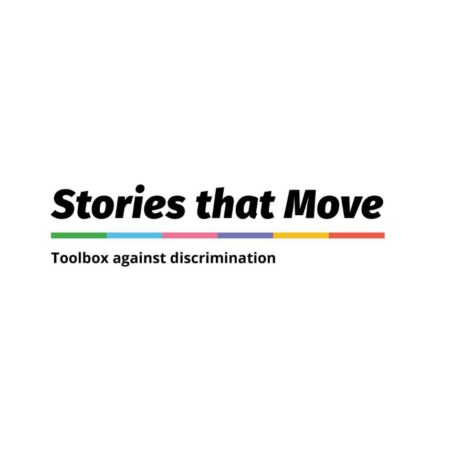Stories that Move
Origin
“Stories that Move – Toolbox against discrimination” is an initiative that was shaped through an international youth meeting held in Berlin in 2013, followed by a meeting of experts from 14 countries in 2014. The project was developed by the Anne Frank House and partners. Stories that Move was developed by a multidisciplinary team from seven countries. Team members are all experienced educators in their countries, working for educational institutions, NGOs and museums, with backgrounds in teaching: arts, history, didactics and human rights. The launch of Stories that Move took place in Berlin in June 2018. The event brought together educators from across Europe who had used the online tool, young people involved in its development and testing, and the international project team. During the event, participants shared their experiences and discussed future plans for the project.
Aims
The project aims to address discrimination and intolerance by empowering young people and providing them with a platform to share their experiences. The project emphasizes the importance of listening to those who have experienced discrimination and intolerance. By incorporating the voices of a wide range of young people, the project aims to create inclusive and safe learning environments. Dialogue is seen as a powerful tool for raising awareness, and the online toolbox provides a space for such dialogue.
Actions
Within the broader scope of discrimination and diversity, the initiative includes resources, materials, and discussions specifically focused on Judaism and antisemitism. These resources provide insights into the experiences of individuals facing discrimination based on their Jewish identity and address the issue of antisemitism in society. Educators can explore these specific materials and incorporate them into their lessons to foster awareness and understanding of antisemitism and promote dialogue on combating prejudice and discrimination against Jewish individuals.
The actions of “Stories that Move – Toolbox against discrimination” revolve around providing accessible resources and promoting dialogue on discrimination and diversity. Here are some key actions undertaken by the initiative:
- Creating Teaching Materials: The project has developed a range of teaching materials that are free and simple to use. These materials are designed to help educators create lessons on discrimination and diversity, both in traditional classrooms and through distance learning. The materials are flexible and accessible, allowing educators to adapt them to their specific needs.
- Learning Paths: The initiative offers five learning paths, each exploring a different topic related to discrimination and diversity. These learning paths serve as complete modules for educators to structure their lessons around. They blend online and offline learning and incorporate group activities to facilitate discussions and the sharing of thoughts and ideas among learners.
- Video Library: “Stories that Move” has curated a library of thought-provoking video interviews. In these videos, young people share their personal experiences and thoughts on discrimination. The videos cover a wide range of topics and are subtitled in seven languages. Educators can use these videos as a basis for lesson plans and facilitate discussions in the classroom.
- Worksheets: The initiative provides downloadable worksheets that are linked to the videos. These interactive PDFs contain questions and discussion points that prompt learners to engage with the video content and reflect on the topics of discrimination and diversity. The worksheets serve as additional resources for educators to incorporate into their lessons.
- Educators’ Guides: For each learning path, “Stories that Move” offers educators’ guides that provide tips, extra information, and guidance on how to create lessons using the toolbox. These guides assist educators in making the most of the available resources and support them in facilitating meaningful discussions on discrimination and diversity.
- Glossary: The initiative provides an alphabetical glossary of terms and definitions related to diversity and discrimination. This glossary is a useful reference tool for educators and learners during lessons, helping them understand and navigate the terminology associated with these topics.
Overall, the actions of “Stories that Move” aim to empower educators and young people to address discrimination and promote dialogue and understanding among learners. The initiative provides a comprehensive toolbox of resources to facilitate inclusive and engaging lessons on these important subjects.



 NOA is co-funded by the Rights, Equality and Citizenship Programme (2014-2020) of the European Union
NOA is co-funded by the Rights, Equality and Citizenship Programme (2014-2020) of the European Union